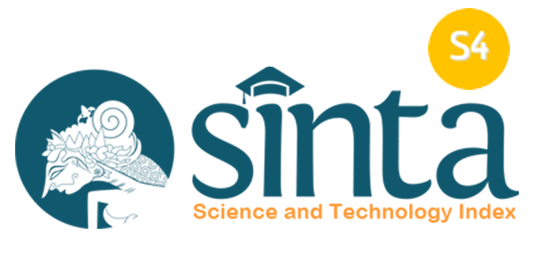Learning Mathematics Formulas by Listening and Reading Worked Examples
Abstract
Keywords
Full Text:
PDFReferences
Alaby, M. A. (2020). Media sosial whatsapp sebagai media pembelajaran jarak jauh mata kuliah ilmu sosial budaya dasar (ISBD). Jayapangus Press, 3(2), 273-289.
Apriliyanto, B. (2019). Analisis kesalahan siswa dalam pemecahan masalah turunan fungsi aljabar. Jurnal Komunikasi Pendidikan, 3(2), 117-125.
Azizah, N., Rosyid, A., and Noorfitriani, I. (2020). Perbandingan kemampuan pemahaman matematis siswa melalui penerapan pembelajaran guided discovery, worked example, dan scientific. Supremum Journal of Mathematics Education, 4(2), 159-169.
Cahdriyana, R. A. and Richardo, R. (2020). Berpikir komputasi dalam pembelajaran matematika. Jurnal Ilmu Pendidikan, 11(1), 50-56.
Chen, O., Retnowati, E. and Kalyuga, S. (2020), Element interactivity as a factor influencing the effectiveness of worked example–problem solving and problem solving–worked example sequences. British Journal of Educational Psychology, 90, 210-223.
Fauziah, A. and Sukasno, S. (2015). Pengaruh model missouri mathematics project (MMP) terhadap kemampuan pemahaman dan pemecahan masalah matematika siswa SMA N I Lubuklinggau. Jurnal Ilmiah Program Studi Matematika STKIP Siliwangi Bandung, 4(1), 10-21.
Hasanah, H. (2019). Analisis kesulitan mahasiswa dalam menyelesaikan soal turunan fungsi aljabar. Jurnal Industri dan Teknologi Terpadu, 2(1), 76-84.
Khotimah, K., Yuwono, I., and Rahardjo, S. (2016). Kesulitan siswa dalam menyelesaikan soal perbandingan trigonometri. Prosiding Seminar Nasional Pendidikan Matematika, Indonesia, 1, 46-52.
Lakens D (2013) Calculating and reporting effect sizes to facilitate cumulative science: a practical primer for t-tests and ANOVAs. Frontier in Psychology, 4, 863.
Lestari, A. C. and Annizar, A. M. (2020). Proses berpikir kritis siswa dalam menyelesaikan masalah PISA ditinjau dari kemampuan berpikir komputasi. Jurnal Kiprah, 8(1), 46–55.
Moreno, R. and Mayer, R. E. (2002). Verbal redundancy in multimedia learning: When reading helps listening. Journal of Educational Psychology, 94(1), 156–163.
Mufidah, S. (2019). Upaya meningkatkan kemandirian belajar siswa dalam pembelajaran matematika menggunakan worked example pada siswa kelas VIII J SMP Negeri 5 Yogyakarta tahun pelajaran 2018/2019. Prosiding Sendika Bidang Pendidikan Matematika, Indonesia, 5, 346-351.
Noorfitriani, I. and Rosyid, A. (2020). Peningkatan kemampuan pemahaman matematis siswa menggunakan worked example. Jurnal Matematika dan Pendidikan Matematika, 5(1), 26-36.
Nurazizah, M., Santosa, C. A. H. F., and Pamungkas, A. S. (2020). Pengaruh model pembelajaran numbered heads together dengan strategi worked-example terhadap kemampuan penalaran siswa. Majalah Ilmiah Kependidikan, 4(1), 1-7.
Retnawati , H., Arlinwibowo , J., and Sulistyaningsih , E. (2017 ). The students ’ difficulties in completing geometry items of national examination. International Journal, 8(4), 03.
Retnowati, E., Ayres, P., & Sweller, J. (2010). Worked Example Effects in Individual and Group Work Settings. Educational Psychology, 30(3), 349-367.
Sahidillah, M. W. and Miftahurrisqi, P. (2019). Whatsapp sebagai media literasi digital siswa. Varia Pendidikan, 31(1), 52-57.
Sung, W., Ahn, J., and Black, J. B. (2017). Introducing computational thinking to young learners: Practicing computational perspectives through embodiment in mathematics education. Technology, Knowledge, and Learning, 22, 443-463.
Supiarmo, M. G., Mardhiyatirrahmah, L., and Turmudi, T. (2021). Pemberian scaffolding untuk memperbaiki proses berpikir komputasi siswa dalam memecahkan masalah matematika. Jurnal Pendidikan Matematika, 5(1), 368-382.
Sweller, J. (2020). Cognitive load theory and educational technology. Education Technology Research and Development, 68, 1-16.
Wing, J. M. (2008). Computational thinking and thinking about computing. Philosophical Transactions of the Royal Society A: Mathematical, Physical and Engineering Sciences, 366(1881), 3717–3725.
Yulistyanti, D., Farkhatin, N., and Mustari, D. (2021). Penggunaan aplikasi sebagai media e-learning remaja di karang taruna. Journal of Empowerment, 2(1), 89-100.
DOI: https://doi.org/10.17509/ijotis.v2i1.45801
Refbacks
- There are currently no refbacks.
Copyright (c) 2022 Universitas Pendidikan Indonesia

This work is licensed under a Creative Commons Attribution-ShareAlike 4.0 International License.
Indonesian Journal of Teaching in Science (IJoTIS) is published by Universitas Pendidikan Indonesia (UPI)
 Indonesian Journal of Teaching in Science
Indonesian Journal of Teaching in Science



